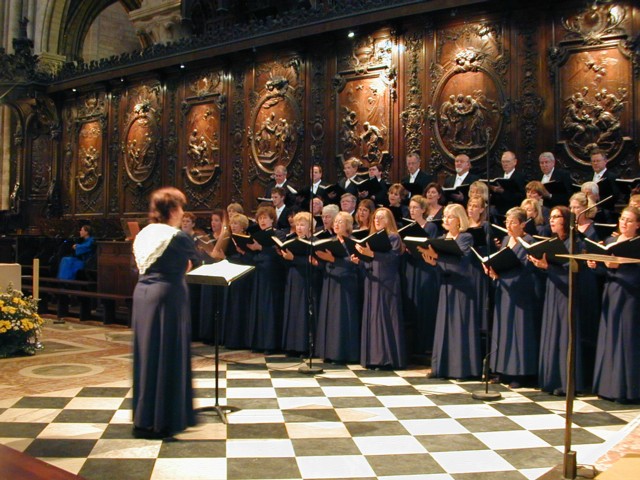

This morning we experienced what will for many of us be the high point of this tour, as we sang during the 11:30 Mass at the Cathedral of Notre Dame. This is the "international" Mass, with readings and prayers in several languages besides French (and Latin). We sang next to the "choir organ" in the middle of the church, and listened to the liturgy and especially the responsive singing; as phrases alternated between a priest or the cantor and the congregation (led by the cantor, the woman in a blue robe seated beyond us in the photo), the accompaniment also shifted between the choir organ and the great organ at the west end of the cathedral. We think we sang at least some of our half-dozen pieces the best we've ever done them, moved by the weight of generations of faith and the beauty of this holy place. Then we joined the recessional of the priests and walked down the aisle two by two and into the sacristy, and not a few of us were wiping away tears by the time Father Michael Perry thanked us for becoming part of the history of Notre Dame, as he put it. Father Perry is the pastor of the church of Our Lady of Refuge in Brooklyn; due to a misunderstanding of which Manhattan we were from, he initially thought we were neighbors! He comes to Notre Dame every July to help with the English translation of the international Mass, and to minister to English-speaking visitors who feel the need to talk to a priest while at Notre Dame. We made a bit of Manhattan Beach Community Church history, in that 4000 people is by far the largest audience for which we've ever sung; but Father Perry was right in saying that we have also added another line to the ancient history of Notre Dame, and we felt deeply honored to have been allowed to contribute to eight hundred years of faith in this world-famous church, and over a thousand more years of faith in Paris before the present cathedral was built. Thanks one last time to Steve Campbell for shooting this photo from the other side of the choir (the section at the middle of the church), where many of our non-singing tour companions sat during the Mass.
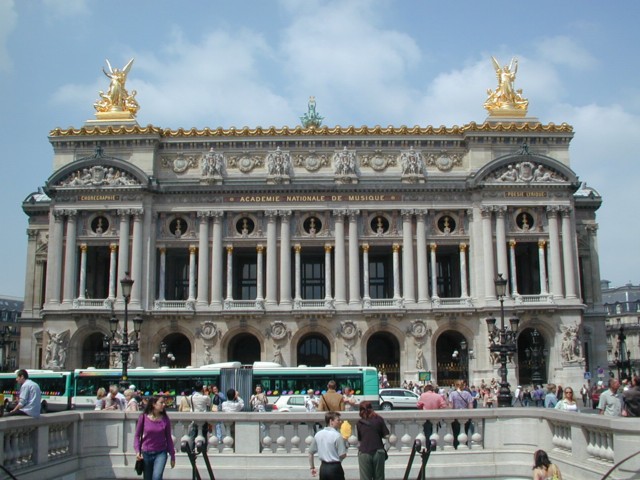
After we said goodbye to Father Perry, we went to have a quick lunch in the vicinity of the Opéra Garnier, and then we divided up into three groups for a guided tour. (Several of us skipped lunch in order to take at least a quick look at the Musée d'Orsay's collection of art from the late 19th and early 20th centuries, since it will be closed tomorrow.) The Paris Opera (the theatrical company, that is, not the building) was chartered in 1669 by Louis XIV; the Palais Garnier is the thirteenth building to house the Opera, since with all the candles inside, and later gaslights, they displayed an alarming tendency to burn down. In fact, though construction of this building (from 1861 to 1875) was delayed by wars and insurrections, in the end its completion was hastened by the need to replace the twelfth building after that one burned down. You can take it as an indication of how seriously the Parisians take their cultural institutions that they weren't going to let a transient thing like a civil war disrupt the continuity of their opera company.
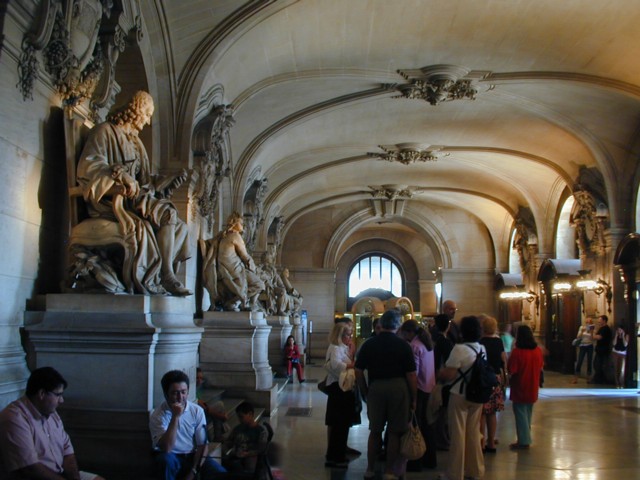
Walking up the steps and through the collonade, you find the entrances for the general public (there was a separate entrance hall for the subscribers, who were the main financial support of the Opera). Outside are busts of several composers, and here are statues of four prominent composers of operas: Rameau, Lulli, Gluck, and Händel. This building was the setting for Gaston Leroux's novel "The Phantom of the Opera," which of course has been made into several movies and Andrew Lloyd Webber's modern musical; in the latter, one of the owners has a line about the gossip-ridden business of the theater: "To hell with Gluck and Händel, it's a scandal that'll pack them in the aisles!", presumably making reference to these statues out front.
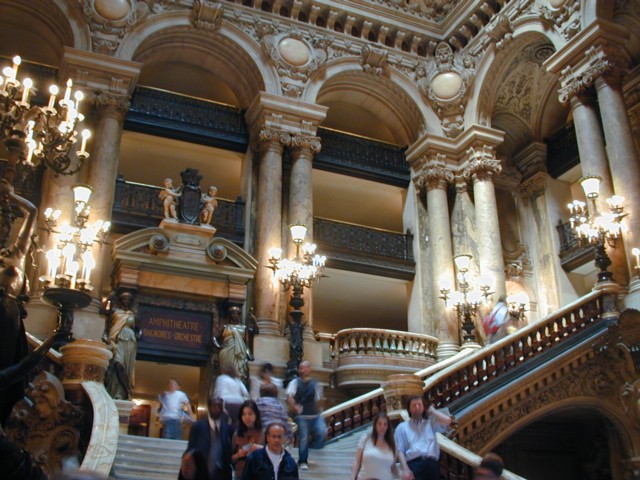
Inside you find yourself facing the grand staircase, which is every bit as opulent as you could hope for if you came here to see and be seen in the late 19th century. The style might be referred to as "eclecticism"; in various places there are formally-posed classical statues, baroque statues, mosaics, tapestries, richly-veined marble, you name it. The architect, Charles Garnier, was a bit of a conservative in some ways; for example, he was one of those I mentioned yesterday who had protested the construction of the Eiffel Tower with its naked steel, and here he kept the steel structure decently clothed in stone. (Again, you can take it as a sign of Parisian seriousness about the creators of their culture that the names of the architects, Garnier and Eiffel, are the ones by which these monuments are known.) However, he was a relative unknown when he won the competition to design the new home of the Paris Opera, and his success caused some sniping by rival architects, one of whom said that usually in an opera house the show is onstage. The construction of this building was part of Napoleon III's campaign to rebuild Paris during the Second Empire, and the Empress was also a detractor. However, when she asked Garnier just what is the style of the building, since it's not Louis XIV or Louis XV or anything else she'd seen, he replied that "it is the style of Napoleon III," to which I presume she had no answer.

We were able to view the auditorium, which as currently configured seats 1900 people, from one of the private boxes. No word on whether this was the famous "box five" that the Phantom ordered to be reserved for his exclusive use! Actually, there were a couple of kernels of fact behind Leroux's story; for example, the Opera rests on caissons sunk into swampland, and while there isn't exactly a "vast glassy lake" beneath it, there is enough water to raise trout, which along with honey from beehives on the roof are a small additional source of income for the theater. And apparently a deformed skeleton was found during reconstruction work below the building, which was where the Phantom ended his days in Leroux's story (it's not addressed in the musical). But as far as I could find out, the rest was the product of Leroux's imagination.
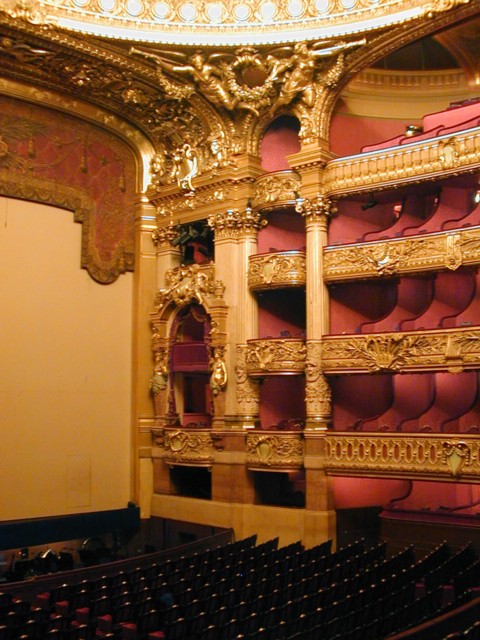
The auditorium is replete with red and gold; the house curtain is canvas painted to look like traditional braided draperies, but there was a scrim in place today. We are looking across at the Emperor's private box, which wouldn't have had the best view in the house from its place of honor a bit too near the stage. Napoleon III went into exile before the theater was completed, so now this box is reserved for the President of the Republic.
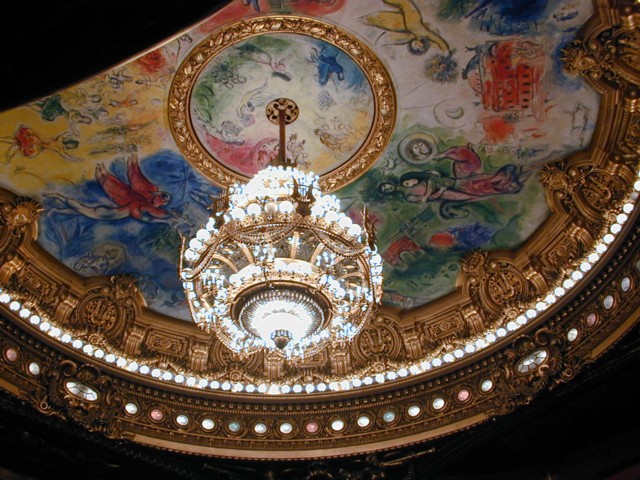
The ceiling is by Marc Chagall; modern art may seem out of place in the Italian-classical style of the theater, but hey, eclecticism, right? The original ceiling is still in place, with Chagall's painting on a disk hung a few feet below it. The chandelier shows the lyre of Apollo, the Greek god of music, which is a recurring theme in the decorations of the theater.
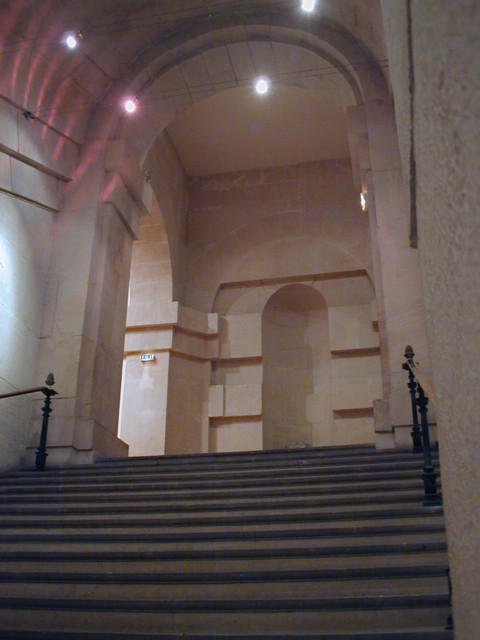
Napoleon III was very fearful of assassination; a number of prominent political figures had been killed on their way to the opera. So, in addition to requiring broad avenues in the rebuilt part of the city outside, with no trees for an assassin to hide behind, he wanted to be able to go directly inside the opera house in his carriage, and go to not just a private box but a whole apartment set aside for his exclusive use. I noted above that he was exiled before the theater was finished, and although Garnier had little regard for the "gray disease" of undecorated stone, the Emperor's apartments were left unfinished, including this staircase.
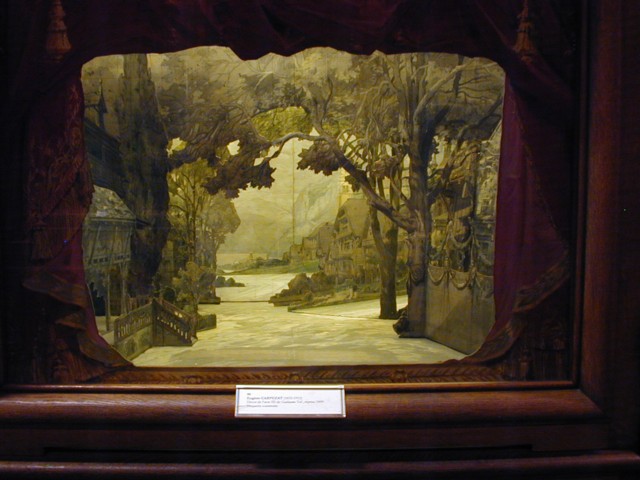
The part of the theater set aside as the imperial apartment now houses a library and art gallery. There are several three-dimensional models of scenery from shows presented here over the years; this is a model of a scene from "William Tell."
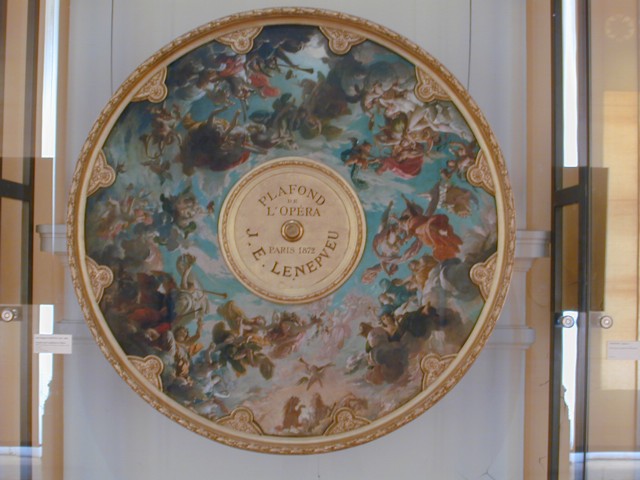
There is also this scaled-down copy of the original 1872 ceiling in the auditorium, now hidden above the Chagall painting.
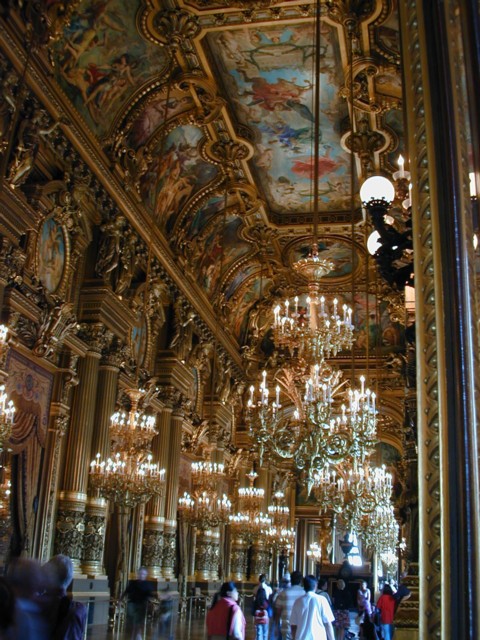
Most definitely not unfinished is the grand foyer, tall enough to hold a five-story building, where theatergoers would have gathered to see and be seen during intermissions. To the left in this view, hidden by columns, are alternating entrances and mirrors which increase even further the sense of spaciousness.

At one side of the auditorium is another room where you might have gone during intermissions, the Salon du Glacier. I'm not sure if "glacier" means a seller of ice cream or just of cold drinks; this was a room where refreshments were served, at any rate, and the tapestries on the wall depict various drinks as well as fishing and hunting. To the left and right of the entrance here you see Tea and Coffee. This room was finished after the opening of the opera house.

We have had some additional company in Paris, as Caroline Rice was joined by her sister and a friend she's known since they were 11. Left to right are sister Sheena Wylie, Caroline, and Helen Smith; Sheena came from London, and Helen was visiting from the town of St. Flovier near Tours, where she had just moved.
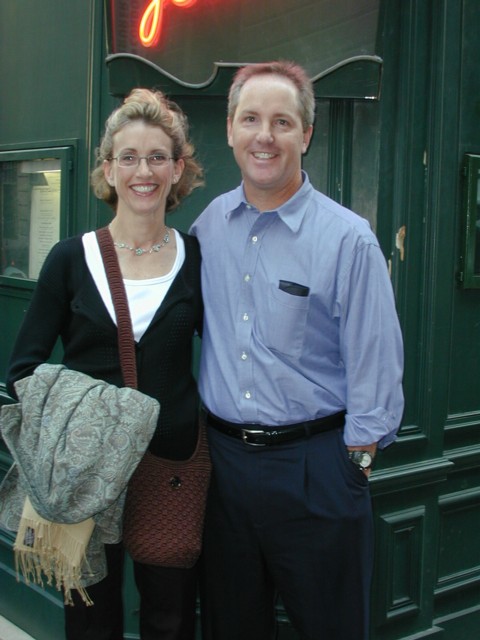
After our tour of the Opéra Garnier we had a couple more hours at liberty, and then we gathered for a farewell dinner (tomorrow night many of us will be going back to the opera house to see a ballet, so we moved the dinner to tonight). We had another guest from even farther away at the dinner: Julie Crum's brother Rob Black is a pilot with American Airlines, and he had a layover in Paris so he came to join us. Actually, he was there at the Mass in Notre Dame this morning; Julie didn't know if he was going to be in town, so it was a nice surprise when he met her afterward!
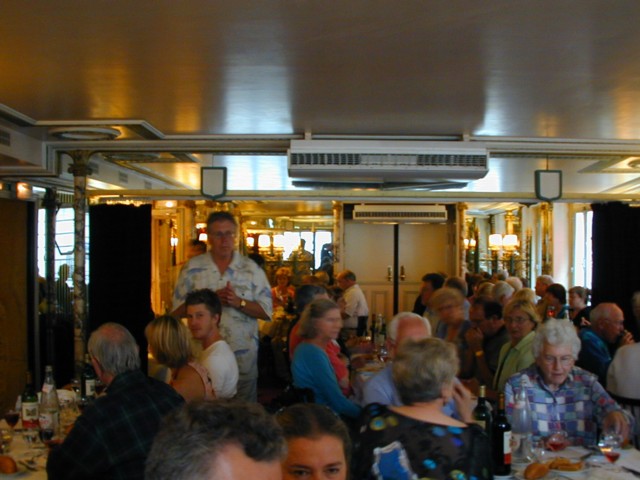
The farewell dinner included toasts, presentations to our escorts and drivers, and a performance by the SQUAKs (Senior Quire United Admiration Korps), the friends and family who traveled with the choir, in which they had some fun with all the things that had happened on the trip, from lost luggage to JC's fascination with military museums to nonfunctioning toilets...
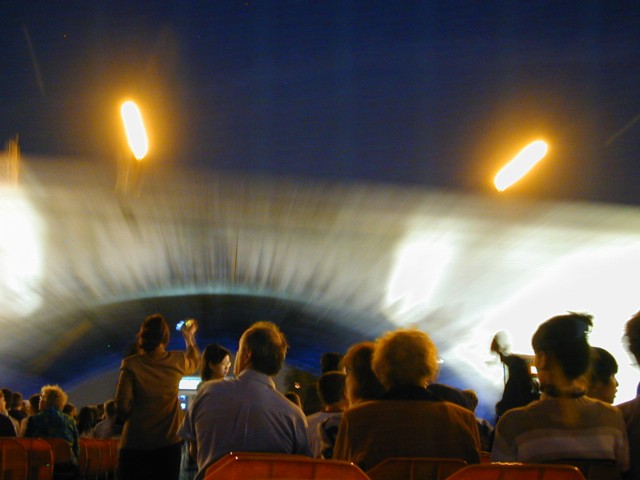
Then we got on the buses one last time to go to the banks of the river Seine and board the Bateaux-Mouches (literally "fly boats," which I presume is in reference to how they skim the water like an insect compared to the heavy cargo barges that also travel the Seine) for a cruise through the heart of the city. The boats have powerful floodlights on their sides to illuminate landmarks like Notre Dame as we pass, and of course the City of Lights has a lot of its own illumination to show. We passed under half a dozen or so bridges, waving to pedestrians overhead and on the banks, as we circled the Île de la Cité and Île Saint-Louis. At the end of the cruise, we climbed to the top of the banks just in time to see the Eiffel Tower, already brightly illuminated (see the photo on the front page of the tour website), begin to sparkle with hundreds of momentary strobes at midnight, as it does each hour in the evening. It was a pretty magical way to end a wonderful day!
 To
Monday, 11 July 2005
To
Monday, 11 July 2005 Back
to choir tour itinerary
Back
to choir tour itinerary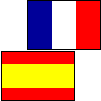 Back
to choir tour home page
Back
to choir tour home pagenew 10 July 2005